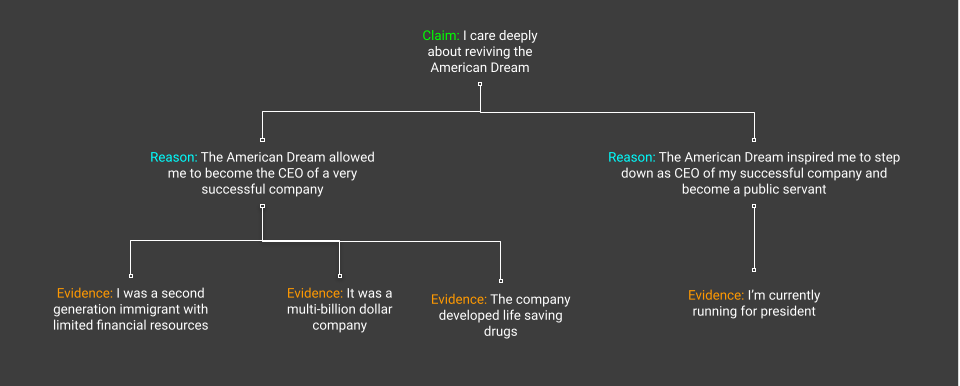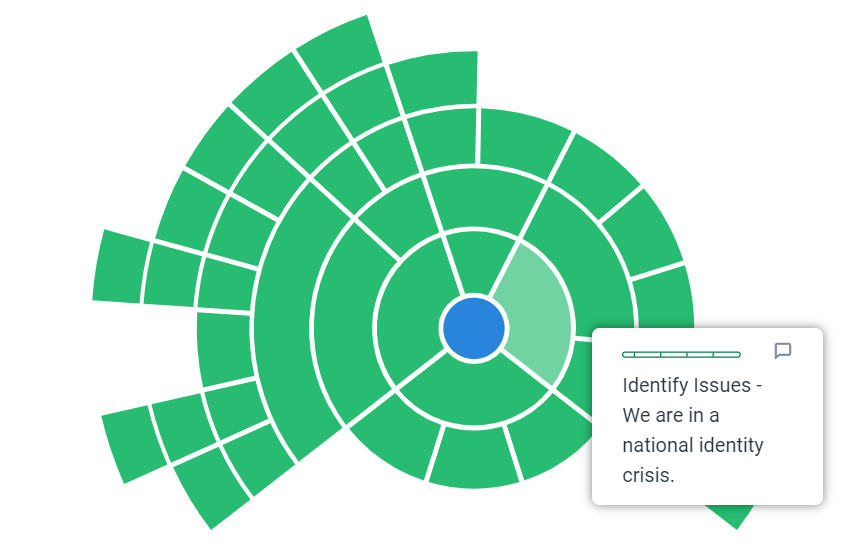Table of Contents
Join me as I perform an argumentation and rhetorical analysis on one of Vivek Ramaswamy’s 2024 GOP candidate speeches. Whether you’re a fan of Mr. Ramaswamy’s policy vision or not, it’s clear that Ramaswamy is an exceptional critical thinker and rhetorician. This series breaks down the rhetorical analysis into a series of posts:
- #1: Rhetorical Analysis – Thesis & Line of Reasoning (this post!)
- #2: Rhetorical Analysis – Claims: Vivek’s Powerful & Awesome Speech Rhetoric
- #3: Rhetorical Analysis – Ethos Pathos Logos: Vivek’s Powerful & Awesome Speech Rhetoric
- #4: Rhetorical Analysis – Devices: Vivek’s Powerful & Awesome Speech Rhetoric
- #5: Speech Modeling – How to use Vivek Ramaswamy’s Rhetoric to create speeches in ChatGPT
- #6: Counterargument – Vivek’s Powerful & Awesome Speech Rhetoric
Subject Analysis Details
- Speech: 2023 Faith & Freedom Coalition
- Speaker/Speechwriter: Vivek Ramaswamy
- Campaign Slogan: Truth
- Date of speech: 06/23/2023
- Speech Length: 14 minutes
- Speech Text: Here
- Rhetoric Type: Constitutive Rhetoric
- provide a collective identity for an addressed audience
- construct the audience as a subject in history; justifying their identity across time
- demand that subjects act in accordance/take action with their identity as enacted in history
Rhetorical Situation
- Exigence: Driven by a concern for the changing cultural landscape in America, especially among the younger generation. It reflects a perceived erosion of traditional values and the search for a unifying American identity. Ramaswamy believes that addressing these challenges is crucial to the future of the nation. Moreover, his political aspirations and vision for the presidency are entwined with this exigence, making it a central theme of his speech.
- Audience: Faith & Freedom Coalition (religious conservative)
- Purpose:
- To advocate for a renewed sense of purpose and meaning in American society.
- To persuade the audience, particularly the conservative base, of the speaker’s vision and political agenda.
- To gain support for his candidacy for the U.S. presidency as a Republican.
Thesis & Line of Reasoning
- Thesis – a statement or theory that is put forward as a premise to be maintained or proved.
- Line of Reasoning – A line of reasoning is a set of reasons that are used to reach a conclusion. It can also be defined as the formal structure of an argument, or the way that claims and reasons are arranged to lead to a conclusion.
In addition to studying his overall art of persuasion, we’ll also be focusing on the specific rhetoric that he uses to directly support his perceived argument thesis and it’s supporting line of reasoning as stated here:
Our traditional vision of the American Dream will revive the nation.
– Vivek Ramaswamy
I leveraged the line of reasoning for this rhetorical model from the four phases of a U.S. political campaign. These phases are identified in the book An Introduction to Political Communication by Brian McNair. Take note of the correlation of LOR #4 – Connect Values/Shared Vision to the concept of Constitutive Rhetoric …pretty much the same concept. This was my primary justification for leveraging these pre-defined four phases for my analysis.
| # | Line of Reasoning | Rhetorical Choice | Argument Claim |
|---|---|---|---|
| 1 | Establish Identity | Connect himself to the American Dream | I care about reviving the American Dream |
| 2 | Identify Issues | Elucidate the issues that are a threat to the American Dream | We are in a national identity crisis |
| 3 | Present Policy | Prescribe the changes needed to revive the American Dream | We must take action to revive the American Dream |
| 4 | Connect Values | Inspire a shared vision of the American Dream | We will restore traditional values and ideals |
The Identify Issues claim was fairly evident as “We are in a national identity crisis” is a direct quote from the speech. The Establish Identity claim “I care about reviving the American Dream” had to be inferred. Here’s a mini argument map to show how I inferred this claim.

I created an argument map (of sorts) of the speech using Kialo. My current method is to organize the speech statements, using the line of reasoning, to understand the overall topology and how each claim statement supports the line of reasoning. I do think I’ll be revising this organization method in the next analysis to maintain a more traditional argument map so that the claim to sub-claim relationship remains intact. The method I have in mind, so I don’t forget, is to keep the Establish Identity line of reasoning isolated and combine the other lines of reasoning together. The other three lines of reasoning are more intertwined and dependent on each other.
During the statement extraction process I always prioritize breaking out the statements by argument claims rather than rhetorical concepts (appeals, devices, etc.). For example, if you were prioritizing the statement breakout by rhetorical devices your statements would end up differently which is OK. I do it this way because I’m most interested in how valid an argument is firstly and then how rhetoric supports the argument secondly.
The Kialo argument map is here. You can participate in this rhetorical analysis by voting on each claim’s impact. Kialo’s impact rating ranges from 0 to 4. You can learn more about the impact rating here.

Line of Reasoning Quiz
Wait!! Before reading any further I welcome you to try this short quiz to test your line of reasoning skills. What could be more fun? That was a rhetorical question. Nothing could be more fun. Take the Quiz.
Rhetorical Data Analysis – Line of Reasoning
Here are some of the observations and data insights I thought were worth noting from the line of reasoning data analysis. I included the line of reasoning data dashboard below this table. Play around with the data and let me know in my YouTube comments if I missed anything of interest.
| # | Data Analysis | Commentary |
|---|---|---|
| 1 | Somewhat even data distribution between the four lines of reasoning | I think this decently even distribution between the lines of reasoning equates to a well balanced speech. |
| 2 | Establish Identity is the smallest line of reasoning at 17% | This makes sense as he didn’t want to over speak about himself. The few claims he makes in this line of reasoning are impactful. |
| 3 | Majority of Establish Identity (83%) is within the speech intro | This is typical in most speeches to establish ethos first and then transition into the central argument |
| 4 | Identify Issues is the greatest line of reasoning at 33% | I believe this is because the argument made within this line of reasoning is the most complex. It involves identifying both the decline and ascension of the nation from its current state of adolescence. |
| 5 | Identify Issues and Connect Values were evenly balanced at 33% vs. 31% | This balance seems logical as the Identify Issues line of reasoning typically focuses on negative claims and Connect Values focuses on positive claims. One is a good counterbalance for the other. |
| 6 | Speech conclusion is primarily Identify Issues at 50% | This seems abnormal as I presume that Connect Values would typically be the highest percentage in the conclusion. I attribute this to the complex argument within the Identify Issues line of reasoning. It is unique in that it inserts optimism into this line of reasoning. |
Rhetorical Data Analysis Dashboard – Line of Reasoning
- Use the Full Screen icon in the bottom right to expand the dashboard
- Use the pie chart to filter by Line of Reasoning
- Use the Speech Section and/or Paragraph filter by speech section
Rhetorical Analysis – Speech Arrangement Summary
- Speech Opening
- Vivek Ramaswamy begins by expressing gratitude and acknowledging the importance of Martin Luther King’s “I Have a Dream” speech.
- He shares his personal journey, from being the child of Indian immigrants to becoming the CEO of a multi-billion dollar company.
- He sets the stage for discussing a “cultural cancer” that threatens the dream Martin Luther King talked about.
- Decline of Traditional American Values
- Vivek Ramaswamy is concerned about the decline of traditional American values, such as faith, patriotism, hard work, and family. These values have historically been seen as central to the American identity.
- This decline is seen as a cultural crisis that threatens the moral fabric of the nation.
- Identity Crisis and Lack of Unity
- The younger generation, represented by the speaker as a millennial, is described as experiencing an identity crisis.
- There is a perceived lack of a unifying American identity that transcends diversity and differences.
- Vivek Ramaswamy sees this as contributing to societal issues and a sense of purposelessness.
- Political and Societal Issues
- The speech alludes to a range of political and social issues, such as affirmative action, border security, and dependence on foreign nations (specifically, the Chinese Communist Party).
- Vivek Ramaswamy presents these issues as problems that require attention and solutions.
- Preservation of American Values
- The overarching exigence is the preservation of what Vivek Ramaswamy views as core American values and principles, such as meritocracy, the rule of law, and the pursuit of truth.
- Vivek Ramaswamy is calling for action to protect and restore these values.
- Speech Conclusion
- Vivek Ramaswamy concludes by emphasizing the potential for America’s ascent and the need for collective effort to preserve the American dream.
